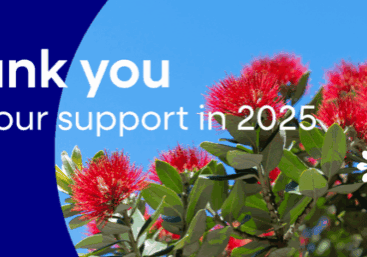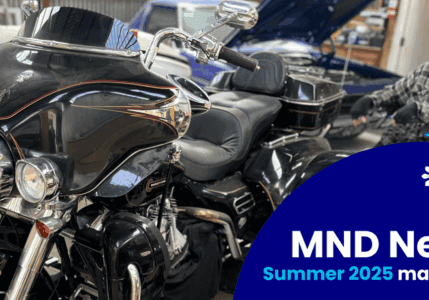2018 Research Update: Clinical Management
Research
23 May 2018

A summary of research from the 2018 Australasian MND Symposium, regarding the clinical management of MND.
This information will be of interest to allied health professionals who work with people with MND in New Zealand.
It includes advice about communicating about sensitive subjects, new respiratory research, and developments in assistive communication technology. 1. Clinical Management
- Golden Rules
- Equipment Communication
- Comfort Care
- Ventilatory assistance overnight
- Ventilatory assistance during the day
- NIV: When to start, when to stop
3. Augmentive & Assistive Communication
- Eye gaze
- Voice banking
- Neuronode
For an easier to read format, please click here for a PDF of the text below.
1. Clinical Management
Simple, practical measures can make a huge difference to people with MND.
There is no recipe, clinical pathway, or magic single solution. Clinical management requires flexibility. Give information to help people make good decisions.
“Doing = Living”. There is a strong connection between meaningful occupational engagement and a client’s self-perception as capable, engaged and having a sense of control and normalcy in their lives.
“Cohesion, participation and meaning”. Occupational interventions promote and expand a person’s engagement and interaction with their environment. Occupational engagement also needs client engagement to form the foundation of meaningful care that extends beyond just symptom management.
NZ application – Is the Occupational Therapist willing to take the helicopter view of a client’s environment outside disease symptom management?
“The most prevalent symptoms are not the most severe.” Pain, nausea, fatigue, weight loss and poor appetite are reported as less challenging than difficulties with sitting, standing and mobility
Golden Rules
1. Understand the phenotype and likely progression
2. Be proactive
3. Be smart and strategic with use of funding available
4. “Close to perfect may be good enough!”
5. Be creative, not prescriptive
6. Put recommendations in writing to maintain good communication with client and team
7. Regular, long term input and support
Equipment Communication
Equipment can be a symbol of loss.
If/when someone isn’t emotionally ready for a piece of equipment, show them what’s available. Roll with what the person is ready to hear. (This can also apply to procedures or advice.)
• “This is what there is – you may or may not need it. You may need to be ‘on the list’ for an item.”
• Use the Hope/Worry technique: “I hope that you will be able to continue… I worry that… ”
• “Other people have found this helpful or useful.”
• “There are always options to assist you further.”
• “Have a look at it” “Touch it” “Try it”
• Not “I think you need….”
• Avoid saying someone refused equipment – they’re just not ready.
• Some equipment may only be useful for a short period of time – that’s okay.
Electric/Hospital Beds
Approach with care and sensitivity. Wait until the person is ready themselves. Consider change to intimacy, relationships. Discuss companion beds.
“What’s most important?”
“Are you willing to trade this for this?”
A hospital bed can represent illness and can install fear that someone may have died on that bed.
NZ application – Conversations about intimacy and ways of accommodating a hospital bed into a couple’s meaning of intimacy rather than the bed signalling the end of their intimacy is important.
Electronic Assistive Technology
Early access to leads to better outcomes. What do they want to be able to do or achieve?
TRIAL and PRACTICE! Review and adjust.
Try using a rubber thimble for typing.
Home Modifications
Consider non-permanent, cheaper, more flexible solutions. Permanent major modifications can be confronting. Look at:
• Temporary ramps
• Recycled rubber shower insert, platform and ramp
• Portable shower base
• Sliding seats
Vehicle Modifications
Particularly needed for clients with lumbar onset MND or PLS.
Safety with Children/Grandchildren
HugMe – Wheelchair User Infant Harness. Suitable for infants 4 months and over. http://www.hugme.co.nz/
Comfort Care
Energy Conservation
Consider:
• Bidet
• Washette Bathroom Aid
• Satin sheet inserts sewn into an overlay
• Quick release NIV mask options using velcro strap
Comfort and Pressure Care
Discomfort is a common issue. Assess person’s description of their discomfort.
Think beyond equipment for solutions. Consider their inability to reposition independently.
• Passive joint ranging
• Massage
• Water therapy
• Carer education
• Use photos for set up and positioning to assist other carers
• Always consider safety
Neck Symptoms
Head droop, shoulder and neck discomfort. The weight of the arms drag on weak neck and shoulder muscles.
• Slings may be useful to take weight off arms, open chest and lift shoulders.
• Try a good quality sweatshirt hoodie with a pocket band at or above waist
• Pushing a stroller or shopping trolley provides support.
• If resistant to using a walker, it’s worth investing in a sportier version!
• Back brace across shoulders
• High backed recliner
• Use of scaphoid nerve block for shoulder pain
• MND Collar (University of Sheffield)
• Different neck collar kits to try; Just use the back portion of the collar
Saliva Management
• 80- 84% pwMND describe some form of oral secretory problem.
- 42% of participants reported excess saliva (Sialorrhoea) or drooling
- 20% thickness
- 18% dry mouth/xerostomia
• Sialorrhoea was reported as being the most difficult and challenging.
• Standardised tools exist to measure Sialorrhoea. No standardise tool is available to assess secretion thickness or xerostomia.
• Tongue weakness exacerbates because the tongue is ineffective at working the saliva around the mouth.
• Using the Sialorrhoea Scoring Scale (SSS) and patient reported Clinical Saliva Scale for MND (CSS-MND) together was suggested as the most suitable for Sialorrhoea management and impact planning.
The above notes refer to the following presentations:
• Assistive Technology usage by people with MND – who needs what and when? Karol Connors, Manager of Physio and OT, Calvary Healthcare Bethlehem, Australia.
• The role of the OT in the lives of people living with MND – navigating an ever-changing level of function. Sarah Solomon, OT, Calvary Healthcare Bethlehem, Australia.
• An update on managing comfort and pressure care for pwMND. Stephanie Williams, OT, Calvary Healthcare Bethlehem, Australia.
• “I just want to ask you something about…” How thought-provoking questions, posed by clients has shaped and guided the development of a new MND service. Renae Knight, OT, Metro South Chronic Disease Service.
• Saliva Assessment in MND: Clinical signs and assessment tools. Evelyn Chew, University of Sydney, Australia.
Respiratory / NIV
Respiratory failure is the major cuase of death in pwMND.
Non-invasive ventilation (NIV) maintains quality of life and extends meaningful survival.
NIV reduces resting energy expenditure which may contribute to slowing of respiratory decline. Improved sleep quality undoubtedly contributes to improved quality of life.
Appropriate caution must be taken when using a face mask if holding it for the patient. If a patient is unable to hold the mask, the person assisting needs to know that there will be a limit to how many breaths can be tolerated, and they need to have a signal to remove the mask. Masks are not as safe as mouthpieces.
NIV mouth pieces can be used away from home, during the day, attached to a wheelchair – therefore pwMND are able to continue to be involved in community activities. Very positive because it reduces the isolation which NIV use increases.
Mechanical Cough Assist machines, used by trained health professionals, has potential to make a difference to some people. The settings need to appropriate for the individual, and reviewed on a regular basis by trained professionals.
Cough assist machines are expensive – Aus$16000 on average. Training is required and it is not an option for end-of-life care.
The ‘hype’ about Cough Assist Machines needs to be kept in context – appropriate for some but not all.
Ventilatory Assistance Overnight
Assoc Prof Amanda Piper
Dept of Respiratory & Sleep Medicine, Royal Prince Alfred Hospital, CamperdownCentral Clinical School, Faculty of Medicine, University of Sydney
• The retention of C02 during sleep and sustained 02 desaturation is the first indication of respiratory deterioration. Under breathing during sleep, because the respiratory muscles have collapsed, leads to poor quality sleep – which can result in headaches/fatigue leading to compromised thinking and longevity.
• The strength of the diaphragm is crucial as reduced REM sleep leads to a poor outcome. This is when there is evidence of diaphragm dysfunction, when FVC <50%.
• NIV was not developed specifically for MND and FVC is a blunt tool (supine FVC more accurate). However there is evidence that starting NIV prior to respiratory decline may slow the decline and lead to longer survival.
• One study showed 13 – 19 months benefit for ALS. Bulbar has conflicting studies but shows improvement.
Ventilatory Assistance During the Day
Nicola Sheers
Senior Respiratory Physiotherapist, VRSS. PhD Candidate, The University of Melbourne
• Respiratory weakness is due to an inefficient ventilatory pump. Over time this leads to decreased respiratory capacity as the chest wall becomes stiffer.
• The combination of reduced ability to take deep breaths and weak abdominal muscles leads to impaired cough, in turn leading to the inability to remove secretions.
• Nocturnal hypoventilation and respiratory tract infection can lead to respiratory failure.
• Respiratory Muscle Training (breath stacking) takes six weeks to improve respiratory function, however this stops when the training stops.
Non-Invasive Ventilation in MND: When to Start, When to Stop
Assoc Prof Mark Howard
Director of the Victorian Respiratory Support Service, Austin Heath, Vic
• Non-invasive ventilation isn’t like taking a pill – it has a big impact on the life of the person with MND and the people around them.
• One of the key symptoms of a weak diaphragm is difficulty breathing when lying flat (orthopnoea) – because gravity doesn’t help. This contributes to poor sleep at night-time.
• Other reasons for referring for ventilation are: dyspnoea (laboured breathing), morning headache, daytime sleepiness, as well as clinical measures of oxygen shortage.
• With non-invasive ventilation – when you breathe, you get a bigger breath.
• NIV can improve quality of sleep, total sleep time (an extra 44 minutes), reduces feeling of breathelssness when lying flat.
• Someone who wants to survive as long as possible and stay active would start NIV early. Someone who just wants to feel most comfortable will start when it may relieve symptoms that bother them. For some people it isn’t appropriate or helpful.
• Some people love it, some people hate it.
Augmentative & Alternative Communication
Common factors:
• Cost of communication technology can be significant ($000s)
• A support person (or team) is needed to troubleshoot tech, help with charging, storage, positioning and updates – may not be suitable for pwMND who live alone
• Need a low-tech back-up option
• Effort required to learn to operate
• Being unfamiliar with technology should not rule people out
Eye gaze
Clinical reasoning for the implementation of eye gaze technology for people with MND
Rachael Russell
Occupational Therapist, Calvory Healthcare Bethlehem, Australia
Eye gaze technology tracks movement of the eye, picking up reflection of the pupil. Eye gaze introduced around 2008, now: more accessible, practical and portable, more flexible mounting options (wheelchair, bed, recliner chair), integrated with mainstream technology (technology eg Windows tablet – iPads don’t have USB port).
Important considerations:
• Cost: $7,000 – $16,000 (AUS$) – funding options to be considered before offer eye gaze as solution.
• Need to think ahead and be prepared when hand function in changing.
• Person w MND needs a support person/team to troubleshoot technology, help charging, storing, positioning, updates etc. Also need a low-tech back-up option.
• Movement as a result of laboured breathing and how this impacts calibration.
• Cognitive change and new learning.
• Eye gaze is tiring – considerable concentration required. Does eye gaze really require less effort than other access methods for that individual?
• Clients need to be motivated and ready to practice.
Benefits of successful implementation:
• reduce carer burden
• improve ability to communicate and reduce anxiety
• provide purpose, sense of enjoyment and meaning
• improve independence and environmental control
• retain employment or volunteering
• maintain sense of self and self-expression, creative outlet
• Can have an amazing impact on quality of life.
If a person with MND is not familiar with technology this should not be a defining factor to rule them out as a candidate for this technology.
Case study: Narelle. Her goals were communication, social media, email, internet access, eBay, e-books, TV control. Different alternate access options were trailed over 3 sessions. First revealed that eye-gaze least fatiguing. Second looked at brands of software and some training to ID the best. Third session did more training and made decisions about mounting.
The set-up takes time – admitting to ward for a week allowed time for training, set up of mounts and apps, training carers. After she goes home follow-up continues. Low-tech back up required, ongoing trouble-shooting, ensuring support people doing updates.
Voice banking
Hold on to your voice: options for voice banking and message banking for people with MND
Charlene Cullen
Speech Pathologist, Assistive Technology Consultant with Link Assistive, Australia
• “Our voice is our acoustical fingerprint” – John Costello
• Traditional voice banking involves recording a large inventory of an individual's speech which is then used to create a synthetic voice that approximates their natural voice.
• Require voice banking service eg ModelTalker, my-own-voice, CereVoiceMe, VOCALiD.
• At end you are given options – voice 1, voice 2, you need to choose which sounds best to you. Can be a difficult choice.
• Once you have a voice banked file, you can use with many apps. Predictable is popular for Mac users. Communicator 5 and Grid 3 popular for Windows – but many other options exist for both.
Barriers to voice banking:
• Cost range from $100 to $4500.
• many hours to do recordings, with fatigue can take weeks/months – requires a great deal of discipline
• recordings should be done at the same time every day in a good recording environment, with good microphone, pwMND may need support for this
• if it looks like a person with MND will be using a device, need to do voice banking as soon as possible
An alternative is message banking:
• digitally recording and storing words, phrases, sentences, personal meaningful sounds and/or stories
• using an individual's natural voice, inflection and intonation
• ‘legacy voice’ for family to listen to after gone
• Can be recorded by a proxy
• messages can be linked to communication apps or speech generating devices
• creates a lot of sound files, need to organise well
• Can be linked to speech generation devices, but can’t create novel messages.
• A good hand-held recorder is recommended. Can be good to record in real-time, naturally over time.
You can donate your voice: vocalid.co/account
NZ Support Workers can make referrals to TalkLink, or the person with MND can also self-refer.
The NeuroNode
Rob Wong
CEO of Control Bionics Inc, Australia
• Wearable and wireless EMG assistive communication and control device, developed in Australia. Allows switch-like access to computer, choose commands based on left-right and up-down scan.
• Small wireless sensor placed on the skin over a muscle chosen to be the switch. When the user attempts to move that muscle the NeuroNode detects their bioelectrical (EMG) signals, even with no visible muscle movement, and uses these signals to allow the user to control their computer, tablet or cellular device.
• Compatible with most popular devices and operating systems.
• Portable, not dependent on lighting or body position
• Threshold settings control for tremor and spasm.
• minimal effort to operate
• extremely low levels of movement generate a positive signal. Can go on any viable muscle site: arm, forehead, quad, jaw – where can you find a muscle that you can still send a signal to?
• can adjust to changes in user’s capability, transfer to a different muscle site as required
• Does it work with non-Bluetooth devices? No.
Cost:
• trial $325 (AUS$) for a week
• to purchase $16,800 (AUS$) “this is not where we would like the cost to be at”
• would require ongoing input and support at an undetermined cost
• Like most technology over time cost decrease and it may be seen widely in use in the future.
Case study: 45 yr old male with MND whose signal declines during the day due to fatigue. Introduced feature that scales threshold throughout day.
Fascinating and very exciting technology. Huge potential for quality of life for a range of people requiring assistive technology.


